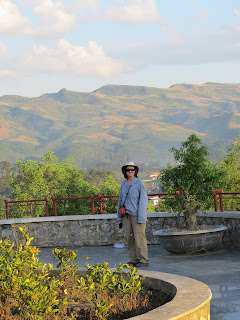 |
| family with child and goat on motorcycle |
We found the driver waiting in the Senally Hotel parking lot, where we had told the travel agency we would be staying, and told him we would be ready after breakfast. With yummy banana pancakes in our tummies, found about a hundred yards downhill of the usual river view restaurant, we packed up and set off by 9 AM. The driver seemed a bit upset, saying we had indicated an 8AM departure, but with his lack of English, and our lack of Vietnamese, we were never sure.
The car was a huge improvement over our Laos vehicles, a New Mitsubishi Pajero sport with 4 - wheel drive, very quiet and clean. scenery was pretty and the road decent but winding. We did not pass many interesting hill tribe villages so there were only a few photo stops before the border.
We reached the Laos exit place, had to call the official over to process our exit stamp, paid 10,000 Kip ($1) each, and we're into Vietnamese territory, but not yet processed in by their immigration post, which was a few miles down the now-deteriorated road. Reaching the post, a large building that could accommodate a hundred office workers, we found it was empty, and we're told the Vietnamese officials would come to process our passports in an hour and a half, at 12:30PM. We were told to wait at a roadside tea stall while our driver went with a soldier to see if he could make it happen sooner.
While we waited, two bicyclists we had seen at the Laos exit point came up, so we told them the immigration offices were empty so they might as well wait with us. They were a Swiss couple who started biking in Vientiene, and we're headed for Hanoi, carrying all their stuff in waterproof saddlebags. At noon the officials came, changed our Laos remaining cash into Vietnamese Dong, and stamped our entry into Vietnam.
Traveling down into the valley, we reached our Muang Than hotel in Dien Bien Phu (last part pronounced as "poo") in half an hour, but found it without electricity, except for their own emergency system. A kind French tour guide who was checking in a dozen of his French clients explained that the electricity should come on by about 5PM. It was never clear to us whether it was a city-wide problem, or just at the hotel. We bought lunch there, but despite an extensive menu, found that we could have either fried rice or noodles, the other items being unavailable. The hotel was strange, a decent shell of a four star place, with carpeting, a decent bathroom with tub, a swimming pool and tennis courts, but gone to seed, no western news channel available, and pretty bad food. Except for the French tour group, we were the only Westerners staying there. This hotel is the best hotel in town!
 |
| Hills surrounding Dien Bien Phou |
We hired a taxi for two hours to see the sights - all related to the 1953-54 siege of a French army force of about 10,000 men that parachuted into Dien Bien Phu for reasons that are not entirely clear, since it was deep in territory controlled by Ho Chi Minh's forces. First we went to the commanding French Gen. deCastries' bunker, where he was captured after the base was under artillery fire for about four months. Quite a depressing place. Then we went to the war museum, all presented from the local's point of view. We saw a video in French that explained how the Vietnamese forces had used thousands of men to haul heavy artillery up the jungled hills, which the French had thought to be impossible. They then pounded the French day and night from the mountains, first making it hard to resupply the French airport,then shooting down planes so that even by parachute, resupply was difficult. The Vietnamese then built trenches around the French positions and overwhelmed them one by one, showing strategy and discipline that the French had not expected. The French surrender demoralized their forces and led to their departure from IndoChina and the agreement to divide Vietnam into North and South, pending a vote which never took place.
 |
| David at the French General's Bunker where he was captured |
Across the street, we looked at the battle cemetery, which only had graves of locals that died in the fight. Presumably the French casualties were taken home, but it is indicative that their casualties were not even mentioned. Nearby, we climbed Hill A-1, which showed the bunkers and hardened trenches that the French had built, but which had been systematically overwhelmed.
We had a not so memorable meal at the hotel, watched a bit of an Asian soft news channel, and went to bed. The same car and driver would be used for our trip tomorrow and we were to be ready to leave by 8pm. We were pleased to have a call from our agent at Topas Travel inquiring if all was in order. The cost of this 2 day private car service was $625.

































